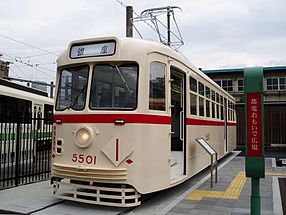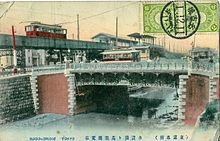Tokyo tram
| Tōkyō urban tram | |
|---|---|
| Car 5501 ( PCC ) as an exhibit in Arakawa | |
| Basic information | |
| Country | Japan |
| city | Tokyo |
| opening | 1882 |
| electrification | 1903 |
| operator | Tokyo Prefecture Transportation Office |
| Infrastructure | |
| Route length | 12.2 km |
| Formerly the largest route |
approx. 213 km |
| Gauge | 1372/1067 mm |
| Power system | 600 V = overhead line |
| Network plan from 1961 | |


The tram Tōkyō , or tram of the (urban) prefecture Tōkyō ( Japanese. 東京 都 電 , Tōkyō-toden ) - formerly urban tram Tōkyō ( 東京 市 電 , Tōkyō-shiden ) - is the tram network of the Japanese capital Tōkyō . It was founded in 1882 as a private horse-drawn tram and after electrification and expansion from 1911 onwards, it was expanded under municipal management until the post-war period. Since 1972 only the existing Arakawa line in the north of the city has been operated.
The private company Tōkyō Basha Tetsudō ( 東京 馬車 鉄 道 ) opened on June 25, 1882 a horse-drawn tram line from Shinbashi / Shiodome ( 新橋 / 汐 留 ) as a circuit through the lower town to Ueno and Asakusa . From 1897 this supplemented a line in 737 mm gauge south to Shinagawa , initially operated by the company Shinagawa Basha Tetsudō ( 品 川馬 車 鉄 道 ) before it was taken over by the former. In the summer of 1903, this was first re-gauged to the future gauge of 1372 mm and electrified; the company became the Tōkyō Densha Tetsudō ( 東京 電車 鉄 道 ) and electrified the rest of the network in the following year, connected with partial re-routing. At the same time, the two companies Tōkyō Shigai Tetsudō ( 東京 市街 鉄 道 ) and Tōkyō Denki Tetsudō ( 東京 電 気 鉄 道 ) built separate networks. All three united in 1906 to the Tōkyō Tetsudō ( 東京 鉄 道 ) and continued the network expansion.
In 1911, the city of Tōkyō took over the operation and continued to expand the route network, so that by the 1930s, practically all inner city districts were developed with a close-knit network. From 1927, the Tōkyō subway also supplemented local transport. Due to political requirements, some networks previously operated by private companies on the outskirts were taken over in 1942; this particularly affected the existing since 1917 Jōtō Denki Kidō ( 城東 電 bestehende 軌道 ) in the east and the 1911 founded Ōji Denki Kidō ( 王子 電 気 軌道 ) in the north. From the Tamagawa Denki Tetsudō ( 玉川 電 気 鉄 道 - the later Tōkyū ) only short routes , built from 1922 east of Shibuya station , became urban in 1938. Between 1924 and 1933 there was also a connection with the Keihin Denki Tetsudō ( 京 浜 電 気 鉄 道 - the later Keihin Kyūkō Dentetsu ) via Shinagawa to Kawasaki . In 1943, the tram service was in the abolition of the city of Tokyo to Tokyo .
After further restructuring due to the war and temporary shutdowns, the network reached its greatest extent of around 213 km west of Shinjuku in 1951 with the acquisition of the Suginami Line ( 杉 並 線 ) built from 1921 by Seibu Tetsudō in 1067 mm gauge . In favor of the trolleybus network operated between 1952 and 1968, only a short line separated from the rest of the route network in the far east was discontinued.
Due to the changed transport policy, parallel to the now resurgent expansion of the underground network, routes were gradually discontinued in a seven-stage process, so that until 1972 only the line that exists today remained. Due to the extensive routing on an independent track, this was hardly an obstacle to individual traffic and, on the other hand, was difficult to replace with buses, which justified continued operation. Potential expansions of the operation - whether starting from the existing route or separately - have never got beyond the discussion stage since then.
Directly next to the existing depot in Arakawa, historical original vehicles are exhibited in a publicly accessible memorial area.




